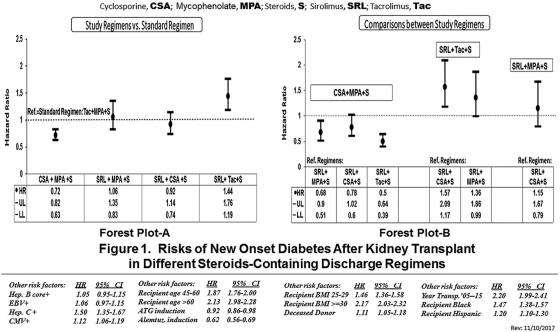New Onset Diabetes after Kidney Transplant: Comparisons of Risks Associated with Various Steroid-Containing Calcineurin Inhibitor and Sirolimus Regimens
A. Santos, Jr.,1 M. Casey,1 K. Alquadan,1 X. Wen,2 C. Chen,3 A. Gutierrez-Mena,1 K. Womer.1
1College of Medicine, Univ. of Florida, Gainesville, FL
2College of Pharmacy, Univ. of Rhode Island, Kingston, RI
3College of Pharmacy, Univ. of Florida, Gainesville, FL.
Meeting: 2018 American Transplant Congress
Abstract number: 340
Keywords: Calcineurin, Glucocortocoids, Metabolic complications, Sirolimus (SLR)
Session Information
Session Name: Concurrent Session: Kidney: Cardiovascular and Metabolic - 2
Session Type: Concurrent Session
Date: Monday, June 4, 2018
Session Time: 4:30pm-6:00pm
 Presentation Time: 5:06pm-5:18pm
Presentation Time: 5:06pm-5:18pm
Location: Room 303
INTRODUCTION: We aimed to examine the risk of new onset diabetes after transplant (NODAT) associated with the following maintenance immunosuppression regimens in kidney transplant recipients (KTR): 1. tacrolimus + mycophenolate+steroids (Tac+MPA+S); 2. Cyclosporine+mycophenolate+ steroids (CSA+MPA+S); 3. sirolimus+mycophenolate+steroids (SRL+MPA+S); 4. sirolimus+cyclosporine+steroids (SRL+CSA+S) and 5. sirolimus+tacrolimus+steroids (SRL+Tac+S).
MATERIALS AND METHODS: We used an observational cohort design to study 1/3/1995-9/15/2015 adult KTR in the Scientific Registry of Transplant Recipients. With Cox regression, we analyzed the 1-year post-transplant risk of NODAT associated with the discharge immunosuppression regimens: CSA+MPA+S, SRL+MPA+S, SRL+CSA+S and SRL+Tac+S; versus the standard regimen: Tac+MPA+S. We compared NODAT risks between study regimens by estimating the differences in their hazard ratios in the Cox model.
RESULTS: Recipient risk factors for NODAT (Footnote Data, Fig. 1) included: Hep C+ or CMV+ serology, higher BMI or age categories and black or Hispanic race. Compared with basiliximab, ATG or alemtuzumab immunosuppression induction was associated with a lower risk of NODAT.
SRL+Tac+S was associated with a higher, CSA+MPA+S with a lower risk of NODAT than standard maintenance immunosuppression regimen (Tac+MPA+S), (Forest Plot A).
Additional comparisons among maintenance regimens showed that CSA+MPA+S was associated with a lower risk of NODAT than SRL+MPA+S or SRL+Tac+S (Forest Plot-B).
Among SRL regimens, SRL+MPA+S and SRL+CSA+S had comparable NODAT risks, while SRL+Tac+S appeared to be associated with the highest NODAT risk (Forest Plot-B).
CONCLUSION: The risks of NODAT in KTR on steroid-containing regimens varied according to the other component-drugs included in those regimens and these factors may be considered in tailoring immunosuppression prescription for KTR.
CITATION INFORMATION: Santos, Jr. A., Casey M., Alquadan K., Wen X., Chen C., Gutierrez-Mena A., Womer K. New Onset Diabetes after Kidney Transplant: Comparisons of Risks Associated with Various Steroid-Containing Calcineurin Inhibitor and Sirolimus Regimens Am J Transplant. 2017;17 (suppl 3).
To cite this abstract in AMA style:
Santos A, Casey M, Alquadan K, Wen X, Chen C, Gutierrez-Mena A, Womer K. New Onset Diabetes after Kidney Transplant: Comparisons of Risks Associated with Various Steroid-Containing Calcineurin Inhibitor and Sirolimus Regimens [abstract]. https://atcmeetingabstracts.com/abstract/new-onset-diabetes-after-kidney-transplant-comparisons-of-risks-associated-with-various-steroid-containing-calcineurin-inhibitor-and-sirolimus-regimens/. Accessed December 17, 2025.« Back to 2018 American Transplant Congress

